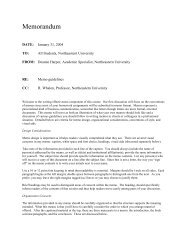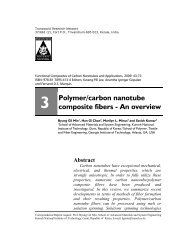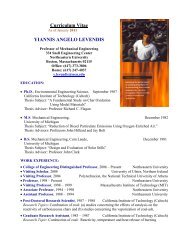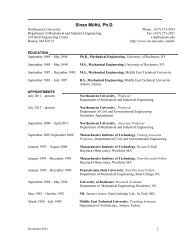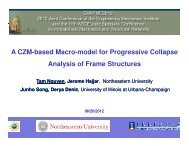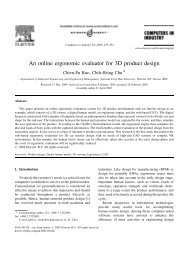You also want an ePaper? Increase the reach of your titles
YUMPU automatically turns print PDFs into web optimized ePapers that Google loves.
210 L. Pallarés, J.F. <strong>Hajjar</strong> / Journal of Constructional Steel Research 66 (2010) 198–212<br />
a b<br />
c d<br />
e<br />
Table 10<br />
Cyclic shear strength of headed studs.<br />
Fig. 6. Comparison between steel (0.65AsFu) <strong>and</strong> concrete predictions with resistance factors <strong>and</strong> type of failure.<br />
Code ξ Reference ξ<br />
AISC 341-05 [31] 0.75 Makino (1984) [58] 0.50<br />
ACI 318-08 [2] b<br />
0.75 Civjan <strong>and</strong> Singh (2003) [38] 0.60 a , b<br />
NEHRP (2004) [59] 0.75 Gattesco <strong>and</strong> Giuriani (1996) [35] 0.90 a<br />
a Failure of the steel.<br />
b Failure of the concrete.<br />
Saari et al. (2004) [39] 0.79 a<br />
metal decking are summarized in Table 10, along with the values<br />
assumed in several design provisions. While there is variation in<br />
the recommendations (for example, ACI 318-08 does not require a<br />
reduction for cyclic loading on the shear strength of steel anchors),<br />
it may generally be concluded that the 25% reduction in monotonic<br />
shear strength to account for cyclic loading is reasonable so long as<br />
the monotonic shear strength is predicted within reasonable statistical<br />
accuracy. For example, a reduction factor of 0.75 is appropriate<br />
when used in conjunction with a Cv coefficient or resistance factor<br />
of 0.65 applied to the nominal shear strength AsFu of a headed stud<br />
anchor with hef /d ratios larger than 4.5.<br />
9. Conclusions<br />
In this work, limit state formulas for headed stud anchors in<br />
shear specifically in composite construction have been assessed<br />
versus 391 monotonic <strong>and</strong> cyclic experiments from the literature<br />
within the context of the AISC Specification [30,31] <strong>and</strong> EC-4 (2004)<br />
[32], <strong>and</strong> comparisons have been made to the provisions in the<br />
ACI 318-08 Building Code [2] <strong>and</strong> the PCI H<strong>and</strong>book, 6th Edition [6].<br />
New formulas are proposed to predict concrete failure <strong>and</strong> existing<br />
formulas for steel failure are evaluated based upon the comprehensive<br />
experimental data set. The experimental results are<br />
disaggregated to highlight tests that failed in the steel shank or<br />
weld, tests that failed in the concrete, or tests that are identified as<br />
having mixed failure. The scope of this research includes composite<br />
beam–columns [typically concrete-encased steel shapes (SRCs) or<br />
concrete-filled steel tubes (CFTs)], concrete-encased <strong>and</strong> concretefilled<br />
beams, boundary elements of composite wall systems, composite<br />
connections, composite column base conditions, <strong>and</strong> related<br />
forms of composite construction; composite beams consisting of<br />
steel girders with composite lightweight concrete slab (with decking)<br />
are out of the scope of this work. Several conclusions can be<br />
drawn from this work.



